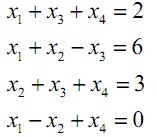Consider the following system of linear equations.

(a) Write out the augmented matrix for this system of linear equations.
(b) Utilize elementary row operations to reduce augmented matrix to reduced row-echelon form.
(c) Write out the answer to the system of linear equations.